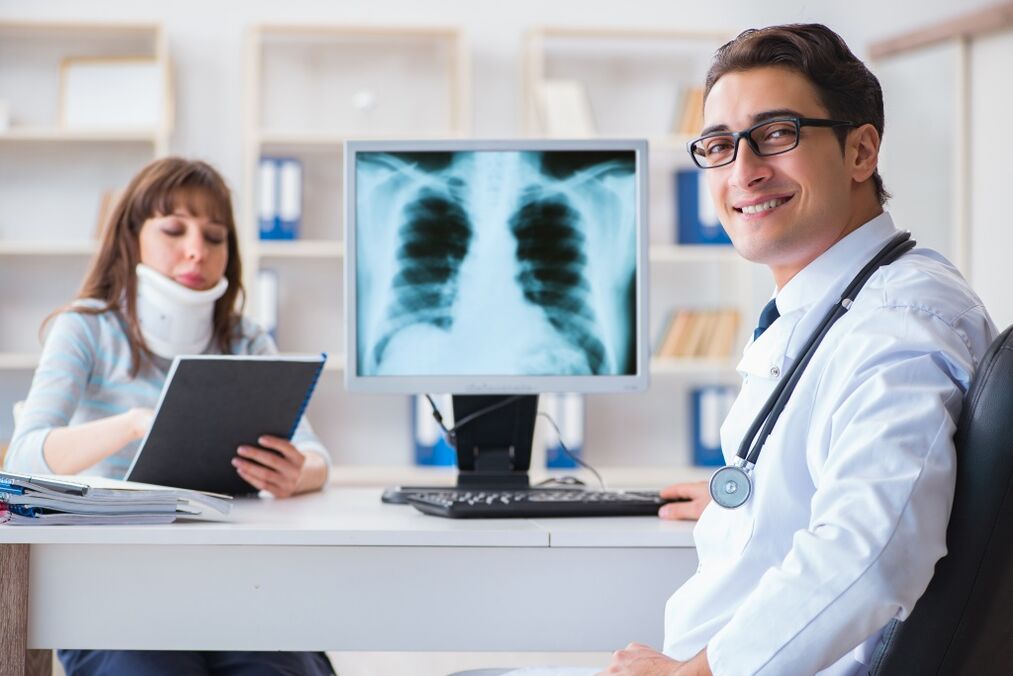
Osteochondrosis is a dystrophic depth disease in which the structure and function of the intervertebral discs violate.Osteochondrosis of the neck is damage to the cervical spine.
During the pathological process with osteochondrosis of the neck of the pulp of the intervertebral disc (its central, soft part), the depreciation properties.The cervical spine loses flexibility, mobility, blood vessels and nerve endings in the channels between the vertebrae.The peculiarity of this pathology is that their symptoms can resemble signs of other diseases, whereby the diagnosis of the disease is difficult and adequate treatment is prescribed too late if there have been irreversible changes in the cartilage tissue.
The cervical osteochondrosis, the symptoms and treatment of which are described below, as well as in cervical osteochondrosis, the middle and older age, formerly in men and a little later in women, and in recent years a significant "rejuvenation" of the neck osteochondrosis has been determined.Of course, over the years, even in a healthy spine, the cartilage tissue of the intervertebral discs is replaced over time with fibrous fibers, it is compressed and hardened.Of course, this process is that it leads to a decrease in the mobility of the spine, but pain is usually not accompanied by pain, since the fibro -boss processes do not influence the nerve endings and do not provoke any injury.In contrast to natural physiological, pathological changes in the intervertebral discs, which are characteristic of osteochondrosis, outside the cartilage spread, which provokes the compression of blood vessels and nerveends, pain and vascular syndrome.
The causes of cervical osteochondrosis
Partly in the development of the osteochondrosis of the neck "guilty", the upset of the modern person and the corresponding distribution of loads along the spine and the natural processes of aging the body tissue.There are also a number of the development and progress of this pathology:
- sitting lifestyle;
- long stay in the same position during work;
- excess body weight;
- persistent injuries to the spine in the neck;
- Chronic stress, constant nervous tension;
- Regular hypothermia of the muscles of the collar zone (for example, if it is near the air flow from the air conditioning);
- Congenital vertebra anomalies and intervertebral discs.
What is the dangerous osteochondrosis of the neck?
At first, osteochondrosis of the neck complicated a number of movements, makes it painful and makes his contribution to the patient's hypodynamy, which is harmful in itself.A vicious circle arises: Small physical activity provokes osteochondrosis, which physically does even less active to the patient, which in turn contributes to the progress of the disease.
In addition, the most important nervous plexus and blood vessels are kept in the channels along the vertebrae of the cervix region, the irritation and violations of which cause reflex headache, chronic dizziness, destabilization of blood pressure, which can inconsistent the patient and reduce the quality of his life considerably.
The particular risk of osteochondrosis of the neck is its difficult diagnosis and a high probability of inadequate treatment.
Symptoms of a neck osteochondrosis
The manifestations of cervical osteochondrosis are worn out, which is very complicated to the diagnosis.As a result, the patient usually addresses the doctor, even if the processes in the intermediate were an irreversible character.The most important symptoms of osteochondrosis of the neck are:
- Dizziness;
- Headache;
- Sharp changes in blood pressure.
All listed signs are not specific, they can not only be displayed for cervical or cervical osteochondrosis, but also for many other diseases.It is therefore very important that one of these symptoms consults a doctor and a complete medical examination is subjected to find out the true cause of the disease.
In addition, cervicalgia is characteristic of the neck osteochondrosis or pain in the neck.It can either be "in the depths" of the neck in the back and the shoulder, hand.The sudden start of a pain attack is characteristic - immediately after awakening, sneezing or coughing, laughing, sharp movement.The pain is usually moderate, is combined with a crispiness in the cervical vertebrae when an attempt is made to turn your head, and after a while after a while the process has not accepted irreversible electricity, it will be waned by itself.
Regardless of this, one should say about fluctuations in blood pressure with cervical osteochondrosis.This is an unspecific symptom, but there are some signs according to which the connection of the blood pressure jumps with osteochondrosis can be established.Such a connection is characterized by blood pressure fluctuations during the day.Long -term hypertension on the contrary is atypical for osteochondrosis.The cause of pressure fluctuations lies in the reflex reaction of the nerve endings in the walls of blood vessels in response to their irritation and compression.As a rule, blood pressure for osteochondrosis with headaches, pain in the limbs, an impairment of the muscles and the sensitivity to skin in the collar zone jumps.
In addition, cervical osteochondrosis is characterized by a number of syndromes (combinations of several symptoms):
- Vertebrae - a number of symptoms associated with damage to the bone tissue of the vertebrae (the pain in the neck when they try to turn your head, the mobility of the cervical spine, the morphological changes in the vertebral bodies and the intervertebral discs);
- Vail arteries syndrome - A number of symptoms that indicate the connection of the pathological process with the vertebral arteries.With inadequate blood flow in the artery, when it is compressed, the noise in the ears, dizziness, blood pressure capabilities, nausea until vomiting, a feeling of the breathtaking.The irritation of the nerve ends in the walls of the arteries is shown by migraines, flickering of "flying in the eyes" and a temporary decrease in visual acuity.Oxygen hunger of the brain tissue, which feeds the vertebral arteries, manifests itself through fainting, chronic sleepiness, a slight, constant headache, a feeling of weakness, a decrease in attention concentration and performance.The syndrome is not only characteristic for osteochondrosis, but also for atherosclerosis and other pathologies of circulatory diseases in the vertebrae arteries;
- Koreshka - It occurs due to the compression of the roots of the spine nerves, a defeated defeat is characteristic.Typical symptoms: pain, impairment of sensitivity, paresis and paralysis of the hands, face and neck;
- Heart - A number of symptoms that occur due to reflex disorders of the heart (pain, burn behind the sternum, shortness of breath, tachycardia).
The degree of the neck of the neck of the neck
The first degree - characterizes the initial stages of the disease, which is clinically manifested and sneezed by pain in the neck after sudden movements.The pain is acute, resembles the unloading of the electrical current.At the same time, the damage to the capsule of the intervertebral disc is morphological, which causes the irritation of the nerve endings.The pain in the neck can be accompanied by pain in the back of the head, noise in the ears and flickering wings in front of his eyes.
The second degree - The progression time of the disease.At this stage, the pain on the neck becomes constant, there is a narrowing of the intervertebral disc holes and in this context - the regular violations of the roots of the spinal nerves and the vessels that take place in them.The capsule of the bandwritten is thinner, the pathological mobility of the spine in this area occurs.The muscle atrophy.The fluctuation of blood pressure is characteristic.In a severe course of the disease, a "symptom of a falling head" can occur - the need to support the head with one hand to relieve pain and repair it in a certain position.
The third degree It is characterized by the destruction of the fibrous ring of the intervertebral disc that the complications of osteochondrosis are possible: transfers of the vertebrae, intervertebral hernia, curvature of the spine.The pain is intense, puts its hand on the shoulder, in addition to the sore throat is disturbed by headaches, dizziness and sharp blood pressure jump.The patient loses the ability to work.
Diagnosis of cervical osteochondrosis

The diagnosis of a "neck osteochondrosis" is based on the examination and overview of the patient, the degree of morphological changes in the intervertebral discs helps to establish an X -ray examination and a magnetic resonance imaging.In addition, it is important to exclude other diseases with similar symptoms: heart attack, high blood pressure, organic brain damage, migraines, for which consultations of related specialists are required.
Treatment of osteochondrosis of the cervical spine
The volume of therapeutic measures for osteochondrosis of the neck depends directly on the degree of the pathological process.The treatment will be all the more effective than before, so it is particularly important to consult a doctor in good time, with the first episodes of pain in the neck, dizziness and not hope that painful symptoms go on.
In the early stages of the disease, the treatment of osteochondrosis of the cervical spine is reduced in order to eliminate the pain syndrome using NSAIDS and pain relievers of local (ointments, creams) or systemically (tablets, injections) of the effect.In addition, the restoration of normal metabolic processes in the cartilaginous tissue of the intervertebral disc plays a major role for which chondroprotectors are used - medication that stimulates the metabolism in cartilage and normalization of its structure.Chondroprotectors stimulate the production processes in the cartilage tissue of prototoglycans, which form the structure of the cartilage.At the same time, inflammation and destructive processes are suppressed in the cartilage.
With the progression of the pathological process, an addition to the therapy described can serve as an anti -spas modos and muscle relaxants in order to eliminate muscle cramp.The doctor can recommend the Novocaine blockade to relieve pain.However, this method can only be attributed to palliatives, which enables the removal of painful symptoms, but does not have the course of the neck of the neck of the osteochondrosis.With advanced osteochondrosis, surgical treatment can be the only effective means, since the possibilities of conservative treatment at this stage are exhausted.
Physiotherapeutic methods for the treatment of osteochondrosis have proven well: electrophoresis, magnetotherapy, ultrasonic therapy, mud.Traditionally important parts of the complex treatment of osteochondrosis are massage and manual therapy. It should be borne in mind that all physiotherapy methods only have to be applied if the neck osteochondrosis is in the remission stage, otherwise you can only activate the pathological process.All manipulations during the massage should be as gently as possible.
It should be borne in mind that all physiotherapy methods only have to be applied if the neck osteochondrosis is in the remission stage, otherwise you can only activate the pathological process.All manipulations during the massage should be as gently as possible.
Medical sports lessons (training therapy) with cervical osteochondrosis
Training therapy is acquired an important role in the treatment of osteochondrosis.Methods of physiotherapy exercises are different.However, their general essence is unchanged: restoration of the healthy mobility of the affected area of the spine and combined with this stimulation of blood supply and the nutrition of the cartilage tissue.With the diagnosis of "cervical osteochondrosis", the exercises should be as economical as possible, the strain on the spine is minimal.Sudden curves, rotation movements, deep tendencies are unacceptable, which can contribute to damage to the capsule of the band pencil leg and worsen the pathological process.
Prevention of the cervical osteochondrosis
The cartilage is not restored and is therefore advisable to prevent its progress than to try to treat the consequences.The basis for the prevention of a neck osteochondrosis is a healthy lifestyle, adequate mobility, rational nutrition, body weight control, small breaks in gymnastics with sedentary professional activities.In addition, you should consult a doctor on the first sign of a dysfunction of the cervical spine.




















